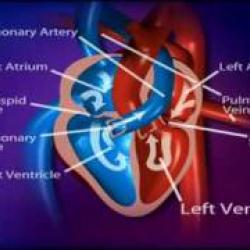The heart is a muscular, fist-sized organ located within your chest in a space between the two lungs (mediastinum). The heart continuously pumps blood, beating as many as 100,000 times a day. The blood that the heart moves carries oxygen and nutrients throughout the body and transports carbon dioxide and other wastes to the lungs, kidneys, and liver for removal.
The heart is supplied with oxygen through a set of coronary arteries and veins. The heart is also an endocrine organ that produces the hormones atrial natriuretic peptide (ANP) and B-type natriuretic peptide (BNP), which coordinate heart function with blood vessels and the kidneys.
The heart is essentially hollow with two halves divided vertically by a septum, and each side of the heart has two internal chambers – an atrium on top and a ventricle on the bottom.
- Blood returning from the body (oxygen-poor) through the veins enters the right side of the heart through the right atrium and is pumped by the right ventricle to the lungs, where carbon dioxide is released and oxygen is taken up.
- This oxygenated blood from the lungs is returned to the left atrium and is pumped by the left ventricle into arteries that carry it throughout the body. Four heart valves regulate the direction and flow of blood through the chambers of the heart. It is their opening and shutting that gives the heart its typical "lub-dub" beat. The heart has an electrical system that controls the rate and rhythm of the heartbeat set by special heart cells called the sinoatrial node or the pacemaker.
The heart muscle itself is called the myocardium. The endocardium is a membrane that lines the chambers of the heart and the valves. The outside of the heart is encased by the pericardium – a layered membrane that is fibrous on the outside and serous (fluid-secreting) on the inside. The pericardium forms a protective barrier around the heart and allows it to beat in a virtually friction-free environment.


